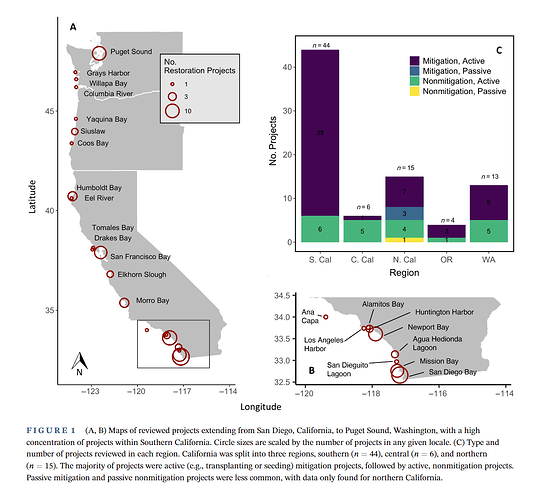Ward, Melissa & Beheshti, Kathryn. (2023). Lessons learned from over thirty years of eelgrass restoration on the US West Coast. Ecosphere (Washington, D.C), 14 (8). https://doi.org/10.1002/ecs2.4642.
Abstract
Seagrass habitats, which provide essential ecosystem functions such as water quality improvement, biodiversity support, ocean acidification amelioration, and sediment carbon storage, are declining worldwide. Eelgrass (Zostera marina) habitats along the contiguous US West Coast are threatened by conflicting human uses and global change, resulting in significant protections of and efforts to restore areas where habitat is extant or degraded. Despite a history of eelgrass restoration in this region spanning nearly 60 years, very little work has been published on the subject. Here, we review all available literature on eelgrass restoration projects conducted in California, Oregon, and Washington. Of the 82 restoration projects included in this analysis, which were conducted from 1989 to 2020, only 6 were published in peer-reviewed journals. Thus, despite the precedent for conducting restoration, a lack of data availability makes assessing regional success, drivers of failure, and best practices extremely difficult. From this synthesis, we find that the majority of restoration projects (73%) have been conducted for mitigation (compliance) purposes, contributing to the lack of peer-reviewed literature on the subject. We find that while eelgrass mitigation policies serve to maintain eelgrass structure and regional acreages, they do not facilitate assessments of habitat function or incentivize advancements in regional best practices. We also find that when we could evaluate project outcomes, 32.3%–59.6% of restoration plots were unsuccessful by the end of the project, but this percentage is highly dependent on how success is defined. According to restoration practitioners, failure was likely to result from environmental factors such as light, nutrients, or macroalgal blooms, but was occasionally due to logistical factors such as restoration method or approach. From this work, we recommend a standardized, evidence-based approach to restoration, improved data sharing practices, and careful consideration of existing eelgrass mitigation practices. As marine habitat restoration enters a new global stage, backed by public and private investment, burgeoning carbon markets, and global biodiversity initiatives, it is essential to learn from past work to understand and improve seagrass conservation and restoration success.
